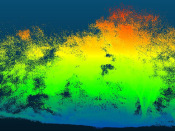Por Jonathan Tawn (Lancaster University - UK).
When assessing the risk posed by environmental processes it is necessary to consider not only the extreme values of the process at separate sites but also the spatial extent of the extreme values in the same event. This spatial information is vital for assessing losses for the insurance industry from flooding or for determining the risk of heatwaves. Clearly events that have a more localized spatial extent to the extreme values will tend to have less severe impacts; so efficient estimation of the spatial behavior of the process is essential for risk assessment.
Extreme value theory provides a very flexible class of asymptotically justified probability distributions to describe the behaviour of the extreme values. In the univariate case the well-established class of distributions fully described by a 3 parameter class of models. This parsimony and flexibly provides a strong basis for modelling. In multivariate and spatial extremes the dependence structure also has critical structure imposed on it by focusing on extreme events. The nature of the structure imposed though depends on the form of the asymptotic argument used and in no case is it fully parameterized.
For spatial modelling of extreme values one asymptotic approach has led to the class of max-stable processes being widely used. A major weakness of these max-stable models is that the spatial profile of events is independent of their peak magnitude. However, for many processes (such as all Gaussian processes) the extreme events becoming increasingly localized as the magnitude of the events become more extreme. In this talk I will introduce spatial extreme value processes that allow for both these of types of spatial extreme process. The properties of these models will be illustrated with applications to the risk assessment for river-flows, heatwaves and offshore waves.
[ver também: Seminário "Regression Type Models for Extremal Dependence" > coffe break entre as 15h30 e as 16h00]













